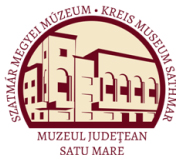Marta, Liviu: The Late Bronze Age Settlements of Petea-Csengersima (Satu Mare, 2009)
VI. Annexes
4,10 m wide. In the northern side it was destroyed by the works of construction and in the other directions it outran the trial trench. In the western side of the cassette, the platform was 20 cm thick, and it grew narrower in the eastern side of the trench. The margin of the platform laid in the confines of the cassette. The platform cut deep into complex 1. S35 Complex 1 - A pit was excavated in the sterile soil, under complex la. It was partially destroyed in the southern side. The outline had initially the shape of an „eight” within the ground-plan, and was 2,30 cm long and 1,68 cm wide. The walls of the pit were 40 cm high and convex. The base was slightly convex and 2,6 cm wide. The fill of the pit comprised a large quantity of daub and carbonized plant remains. The half of a bowl which laid standing in the northern side of the pit was untouched by the excavator. The „eight” shape of the contour indicated the existence of two pits, but the common fill and the similar duct of the walls showed that it was only one pit that was filled at the same time with the waste of complex la. Pottery shape Paste Decoration type Pottery typeNo. of elements Plate dish f AA 2Ac 1 40/16 cup f AE,GF,IA 4 1 41/1 f KB 1 41/2 dish f IG 1 41/3 f GA 1 41/9 cup f DF 1 Ba 1 41/10 amphora f GA 2B 1 41/11 f GE,LG 1 42/2 f GC,GG 1 42/3 Sector S36 (340,61 m2, Fig. 11) S36 Complex 2 (Fig. 11, 14) — A pit with amorphous shape and with the outline (138 x 142 cm) delimited in the sterile soil. The walls were shallow (16 cm high), but in the southern corner they were 36 cm high. In that depth, the outline of the pit became circular (70 cm in diameter). The base was irregular. The fill was dark-grey and it contained charcoal and scattered fragments of daub. Inventory: 87 ceramic shards, three pieces of daub of a hearth, small bones, many daub fragments, of which, the majority preserved impressions of tree rods and leaves. Some ceramic shards originated from 32 vessels. Seven fragments that originated from 6 vessels had excised-incised decorations. Suciu de Sus. S36 Complex 3 (Fig. 11, 14) — A pit laid in the border of the section and thus it was partially excavated on an arched surface (90 x 133 cm). It occurred in the sterile soil in 60 cm depth, in the south-eastern corner of the trench. The walls were arched and 34 cm high. The base was irregular. The grey fill contained brown inclusions, charcoal and scattered fragments of daub. No ceramic inventory. Not assigned to an archaeological culture. S36 Complex 4 (Fig. 11, 14) — A pit was partially excavated on an arched surface (64 x 143 cm). It had irregular outline that occurred in the sterile soil in 60 cm depth, in the southern margin of the trench. The walls were steep and 23 cm high. The base was irregular and the fill was brown-grey with scattered fragments of daub. Two post holes laid in the north-eastern corner of the pit: 4A and 4B. They had circular outline (45 cm) or oval outline (45 x 57 cm), steep walls, 24 cm or 21 cm high, flat base, brown-grey fill with scattered fragments of daub. No ceramic inventory. Not assigned to an archaeological culture. S36 Complex 5 (Fig. 11, 14) — Two crosscutting pits occurred as an amorphous inclusion (maximum diameter 181 x 196 cm) in the sterile soil, in 60 cm depth. The pit was very shallow in the northeastern side (5-7 cm deep), but in the half-western side it was oval (108 x 170 cm) with vertical walls and 58 cm high. The fill was dark-brown, with scattered fragments of daub. North-eastwards from pit 5 were two post holes (?), 5A and 5B, both with circular outline (48 cm and 40 cm, respectively, in diameter). They had steeply inclined walls towards the inside, of 10 cm and 8 cm high, respectively. Their base was flat and the fill was dark-brown with scattered fragments of daub. Inventory: 74 ceramic shards, 20 pieces of daub, four fragments of a hearth clay, two fragments of grinding stone and a few fragmented bones. Fourteen ceramic shards originated from five vessels and had excisedincised decorations. Date/culture: Suciu de Sus. 138
